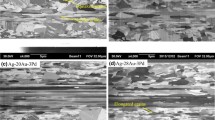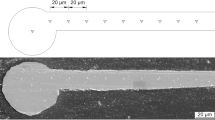Abstract
The evolutions of the surface morphologies, cross-sectional microstructures, and mechanical properties of two types of Ag-based alloy wires with different Au contents under a 105 A/cm2 electrical current density across various times were compared in this study. Ag-based alloy wires that contain 8 wt% Au and 15 wt% Au with 3 wt% Pd were produced via rapid drawing and multiple annealing processes to replace commercial Au-bonded wires in the electronic packaging industry. The surface morphologies of these wires were revealed by scanning electron microscopy (SEM), and cross-sectional microstructures were analyzed by electron back scattering diffraction (EBSD). The SEM observations showed grain- and step-like structures in the Ag–8Au–3Pd and Ag–15Au–3Pd wires after a 5-h treatment, respectively. EBSD results revealed a change in the main preferred orientation from <001> slender grains to <111> equiaxed grains because the high-angle grain boundaries (HAGB) were reduced, and the twin boundaries (TB) were multiplied along the drawing direction. In terms of mechanical properties, Ag–15Au–3Pd wire showed better breaking loads and elongations than Ag–8Au–3Pd wire. The Au effect in Ag-based alloy wires reduced the atomic diffusion to stabilize grain structures and induce a dislocation accumulation, which subsequently improved the mechanical properties by retaining and forming HAGBs, LAGBs, and TBs under high current stressing.




















Similar content being viewed by others
References
P.B. Ghate, Electromigration-induced failures in VLSI interconnects. IEEE Int. Reliab. Phys. Symp. Proc. 20, 292–299 (1982)
J.R. Black, Electromigration failure modes in aluminum metallization for semiconductor devices. Proc. IEEE 57, 1587–1594 (1969)
H.B. Huntington, A.R. Grone, Current-induced marker motion in gold wires. J. Phys. Chem. Solids 20, 76–87 (1961)
J.A. Nucci, A. Straub, E. Bischoff, E. Arzt, C.A. Volkert, Growth of electromigration-induced hillocks in Al interconnects. J. Mater. Res. 17, 2727–2735 (2002)
T. Marieb, P. Flinn, J.C. Bravman, D. Gardner, M. Madden, Observations of electromigration induced void nucleation and growth in polycrystalline and near-bamboo passivated Al lines. J. Appl. Phys. 78, 1026–1032 (1995)
R. Spolenak, O. Kraft, E. Arzt, Effects of alloying elements on electromigration. Microelectron. Reliab. 38, 1015–1020 (1998)
F. d’Heurle, The effect of copper additions on electromigration in aluminum thin films. Metall. Trans. 2, 683–689 (1971)
T.H. Chuang, H.J. Lin, C.H. Chuang, Y.Y. Shiue, F.S. Shieu, Y.L. Huang, P.C. Hsu, J.D. Lee, H.H. Tsai, Thermal stability of grain structure and material properties in an annealing twinned Ag–4Pd alloy wire. J. Alloys Compd. 615, 891–898 (2014)
T.H. Chuang, H.C. Wang, C.H. Tsai, C.C. Chang, C.H. Chuang, J.D. Lee, H.H. Tsai, Thermal stability of grain structure and material properties in an annealing-twinned Ag–8Au–3Pd alloy wire. Scr. Mater. 67, 605–608 (2012)
R. Guo, L. Gao, M. Li, D. Mao, K. Qian, H. Chiu, Microstructure evolution of Ag–8Au–3Pd alloy wire during electromigration. Mater. Charact. 110, 44–51 (2015)
K.C. Chen, C.N. Liao, W.W. Wu, L.J. Chen, Direct observation of electromigration-induced surface atomic steps in Cu lines by in situ transmission electron microscopy. Appl. Phys. Lett. 90, 203101 (2007)
L. Lu, Y. Shen, X. Chen, L. Qian, K. Lu, Ultrahigh strength and high electrical conductivity in copper. Science 304, 422–426 (2004)
J.D. Lee, H.H. Tsai, T.H. Chuang, Patent US8940403B2 (2012)
S.P. Riege, J.A. Prybyla, A.W. Hunt, Influence of microstructure on electromigration dynamics in submicron Al interconnects: real-time imaging. Appl. Phys. Lett. 69, 2367–2369 (1996)
J.R. Bowen, P.B. Prangnell, D.J. Jensen, N. Hansen, Microstructural parameters and flow stress in Al–0 13% Mg deformed by ECAE processing. Mater. Sci. Eng. A 387–389, 235–239 (2004)
J.P. Hou, Q. Wang, H.J. Yang, X.M. Wu, C.H. Li, X.W. Li, Z.F. Zhang, Microstructure evolution and strengthening mechanisms of cold-drawn commercially pure aluminum wire. Mater. Sci. Eng. A 639, 103–106 (2015)
X.M. Luo, Z.M. Song, M.L. Li, Q. Wang, G.P. Zhang, Microstructural evolution and service performance of cold-drawn pure aluminum conductor wires. J. Mater. Sci. Technol. 33, 1039–1043 (2017)
J.A. Venables, The nucleation and propagation of deformation twins. J. Phys. Chem. Solids 25, 693–700 (1964)
J.W. Park, H.J. Jeong, S.W. Jin, M.J. Kim, K. Lee, J.J. Kim, S.T. Hong, H.N. Han, Effect of electric current on recrystallization kinetics in interstitial free steel and AZ31 magnesium alloy. Mater. Charact. 133, 70–76 (2017)
P.C. Liang, K.L. Lin, Non-deformation recrystallization of metal with electric current stressing. J. Alloys Compd. 722, 690–697 (2017)
V. Randle, H. Davies, I. Cross, Grain boundary misorientation distributions. Curr. Opin. Solid State Mater. Sci. 5, 3–8 (2001)
T. Hu, K. Ma, T.D. Topping, B. Saller, A. Yousefiani, J.M. Schoenung, E.J. Lavernia, Improving the tensile ductility and uniform elongation of high-strength ultrafine-grained Al alloys by lowering the grain boundary misorientation angle. Scr. Mater. 78–79, 25–28 (2014)
S. Ranganathan, On the geometry of coincidence-site lattices. Acta Crystallogr. 21, 197–199 (1966)
S. Kobayashi, R. Kobayashi, T. Watanabe, Control of grain boundary connectivity based on fractal analysis for improvement of intergranular corrosion resistance in SUS316L austenitic stainless steel. Acta Mater. 102, 397–405 (2016)
V. Randle, Twinning-related grain boundary engineering. Acta Mater. 52, 4067–4081 (2004)
G. Palumbo, K.T. Aust, U. Erb, P.J. King, A.M. Brennenstuhl, P. Lichtenberger, On annealing twins and CSL distributions in fcc polycrystals. Phys. Status Solidi A 131, 425–428 (1992)
V. Randle, Mechanism of twinning-induced grain boundary engineering in low stacking-fault energy materials. Acta Mater. 47, 4187–4196 (1999)
K.C. Chen, W.W. Wu, C.N. Liao, L.J. Chen, K.N. Tu, Observation of atomic diffusion at twin-modified grain boundaries in copper. Science 321(5892), 1066–1069 (2008)
K. Edalati, D. Akama, A. Nishio, S. Lee, Y. Yonenaga, J.M. Cubero-Sesin, Z. Horita, Influence of dislocation–solute atom interactions and stacking fault energy on grain size of single-phase alloys after severe plastic deformation using high-pressure torsion. Acta Mater. 69, 68–77 (2014)
S. Qu, X.H. An, H.J. Yang, C.X. Huang, G. Yang, Q.S. Zang, Z.G. Wang, S.D. Wu, Z.F. Zhang, Microstructural evolution and mechanical properties of Cu–Al alloys subjected to equal channel angular pressing. Acta Mater. 57, 1586–1601 (2009)
B.C. Kim, S. Lee, N.J. Kim, D.Y. Lee, Microstructure and local brittle zone phenomena in high-strength low-alloy steel welds. Metall. Trans. A 22, 139–149 (1991)
T.H. Chuang, H.J. Lin, C.H. Chuang, C.H. Tsai, J.D. Lee, H.H. Tsai, Durability to electromigration of an annealing-twinned Ag-4Pd alloy wire under current stressing. Metall. Mater. Trans. A 45, 5574–5583 (2014)
N. Kamikawa, X. Huang, N. Tsuji, N. Hansen, Strengthening mechanisms in nanostructured high-purity aluminium deformed to high strain and annealed. Acta Mater. 57, 4198–4208 (2009)
N. Hansen, Hall-Petch relation and boundary strengthening. Scr. Mater. 51, 801–806 (2004)
M. Dao, L. Lu, Y.F. Shen, S. Suresh, Strength, strain-rate sensitivity and ductility of copper with nanoscale twins. Acta Mater. 54, 5421–5432 (2006)
Acknowledgements
The authors gratefully acknowledge the financial support for this research by the Ministry of Science and Technology of Taiwan under Grant No. NSC 106-2221-E-005-026-MY3. The present work was also supported in part by the Center for Micro/Nano Science and Technology of the National Cheng Kung University and Innovation and Development Center of Sustainable Agriculture (IDCSA).
Author information
Authors and Affiliations
Corresponding author
Additional information
Publisher's Note
Springer Nature remains neutral with regard to jurisdictional claims in published maps and institutional affiliations.
Rights and permissions
About this article
Cite this article
Kuo, BH., Tsai, DC., Huang, YL. et al. Au-induced improvements in the grain stability and mechanical properties of Ag-based alloy wires under electrical current stressing. J Mater Sci: Mater Electron 30, 15897–15911 (2019). https://doi.org/10.1007/s10854-019-01936-3
Received:
Accepted:
Published:
Issue Date:
DOI: https://doi.org/10.1007/s10854-019-01936-3




